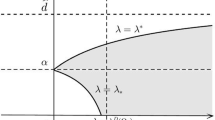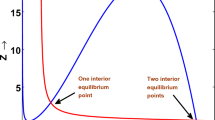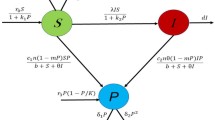Abstract
In this work, we have formulated and analyzed a fractional-order predator–prey model with an asymptotic incidence rate and constant prey refuge. Due to vulnerability, it is assumed that predator consumes only infected prey. Our mathematical formulation of the non-integer-order initial value problem has been developed on the famous fractional-order Caputo derivative. The main objective of this work is to investigate the influence of fractional-order derivatives on the system over the classical integer-order model. We have discussed the existence of non-negative solution, uniqueness and boundedness of our considered model. Analysis of local stability and Hopf bifurcation are performed both analytically and numerically. Sufficient conditions are established to guarantee the global stability of the interior equilibrium point by constructing a suitable Lyapunov function. Finally, some numerical simulations are provided to validate our results.






Similar content being viewed by others
References
Abbas S, Mahto L, Favini A, Hafayed M (2016) Dynamical study of fractional model of allelopathic stimulatory phytoplankton species. Differ Equ Dyn Syst 24:267–280
Abdelouahab MS, Hamri N, Wang J (2012) Hopf bifurcation and chaos in fractional-order modified hybrid optical system. Nonlinear Dyn 69:275–284
Ahmed E, El-Sayed AMA, El-Saka HAA (2006) On some Routh-Hurwitz conditions for fractional order differential equations and their applications in Lorenz, Rossler, Chua and Chen systems. Phys Lett A 358:1–4
Ahmed E, El-Sayed AMA, El-Saka HAA (2007) Equilibrium points, stability and numerical solutions of fractional-order predator-prey and rabies models. J Math Anal Appl 325:542–553
Assaleh K, Ahmad WM (2007) Modelling of speech signals using fractional calculus. In: 9th International Symposium on signal processing and its applications (ISSPA 2007)
Bera SP, Maiti A, Samanta GP (2015) A prey-predator model with infection in both prey and predator. Filomat 29(8):1753–1767. https://doi.org/10.2298/FIL1508753B
Choi SK, Kang B, Koo N (2014) Stability for Caputo fractional differential systems. Abstr Appl Anal 2014:1–6
Cole KS (1993) Electric conductance of biological systems. In: Cold Spring Harbor Symposium on quantitative biology, pp 107–116
Das S, Mahato P, Mahato SK (2020) Disease control prey-predator model incorporating prey refuge under fuzzy uncertainty. Model Earth Syst Environ. https://doi.org/10.1007/s40808-020-00892-w
Debnath L (2003) Recent applications of fractional calculus to science and engineering. Int J Math Math Sci 54:3413–3442
Diethem K, Ford NJ, Freed AD (2002) A predictor corrector approach for the numerical solution of fractional differential equations. Nonlinear Dyn 29:23–22
Elsadany AA, Matouk AE (2015) Dynamical behaviors of fractional-order Lotka-Volterra predator-prey model and its discretization. J Appl Math Comput 49:269–283
El-Sayed S (1998) Nonlinear functional differential equations of arbitrary orders. Nonlinear Anal Theory Methods Appl 33(2):181–186
El-Sayed A, El-Mesiry A, EL-Saka H (2007) On the fractional order logistic equation. Appl Math Lett 20(7):817–823
Fedri Y (2012) Some applications of fractional order calculus to design digital filters for biomedical signal processing. J Mech Med Biol 12(2):13
Ghaziani R, Alidousti J, Eshkaftaki AB (2016) Stability and dynamics of a fractional order Leslie- Gower prey-predator model. Appl Math Model 40:2075–2086
Gonzalez-Olivares E, Ramos-Jiliberto R (2003) Dynamic consequences of prey refuges in a simple model system: more prey, fewer predators and enhanced stability. Ecol Model 166:135–146
Hadeler KP, Freedman HI (1989) Predator-prey populations with parasitic infection. J Math Biol 27:609–631
Haque M, Venturino E (2009) Modelling disease spreading in symbiotic communities. Wildlife: destruction, conservation and biodiversity. Nova Science Publishers
Hethcote H, Wang W, Han L, Ma Z (2004) A predator-prey model with infected prey. Theor Popul Biol 66:259–268
Holt RD, Roy M (2007) Predation can increase the prevalence of infectious disease. Am Nat 169:690–699
Hsieh YH, Hsiao CK (2008) Predator-prey model with disease infection in both populations. Math Med Biol 25:247–266
Huang Y, Chen F, Zhong L (2006) Stability analysis of a prey-predator model with Holling type III response function incorporating a prey refuge. Appl Math Comput 182:672–683
Hudson PJ, Dobson AP, Newborn D (1992) Do parasite make prey vulnerable to predation Red grouse and parasite. J Anim Ecol 61:681–692
Huo J, Zhao H, Zhu L (2015) The effect of vaccines on backward bifurcation in a fractional order HIV model. Nonlinear Anal 26:289–305
Jana D, Ray S (2016) Impact of physical and behavioral prey refuge on the stability and bifurcation of Gause type Filippov prey-predator system. Model Earth Syst Environ. https://doi.org/10.1007/s40808-016-0077-y
Javidi M, Nyamoradi N (2013) Dynamic analysis of a fractional order prey-predator interaction with harvesting. Appl Math Model 37:8946–8956
Ji G, Ge Q, Xu J (2016) Dynamic behaviors of a fractional order two-species cooperative systems with harvesting. Chaos Solitons Fract 92:51–55
Kar TK (2006) Modelling and analysis of a harvested prey-predator system incorporating a prey refuge. J Comput Appl Math 185:19–33
Kermack W, McKendrick A (1927) A contribution to the mathematical theory of epidemics. Proc R Soc A 115:700–721
Krivan V (1998) Effects of optimal anti predator behavior of prey on predator-prey dynamics: the role of refuges. Theor Popul Biol 53:131–142
Krivan V (2011) On the Gause predator-prey model with a refuge: A fresh look at the history. J Theoret Biol 274:67–73
Li C, Tao C (2009) On the fractional Adams method. Comput Math Appl 58(8):1573–1588
Li HL, Long Z, Cheng H, Yao-Lin J, Zhidong T (2016) Dynamical analysis of a fractional-order predator-prey model incorporating a prey refuge. J Appl Math Comput 54:435–449
Machado JAT (2010) Entropy analysis of integer and fractional dynamical systems. Nonlinear Dyn 62(1–2):371–378
Machado JAT, Galhano AMSF (2012) Fractional order inductive phenomenona based on the skin effect. Nonlinear Dyn 68(1–2):107–115
Maji C, Kesh D, Mukherjee D (2019) Bifurcation and global stability in an eco-epidemic model with refuge. Energ Ecol Environ 4:103–115
Maji C, Mukherjee D, Kesh D (2020) Study of a fractional-order model of chronic wasting disease. Math Methods App Sci 43(7):4669–4682
Mandal M, Jana S, Nandi SK et al (2020) Modeling and analysis of a fractional-order prey-predator system incorporating harvesting. Model Earth Syst Environ. https://doi.org/10.1007/s40808-020-00970-z
Matouk AE, Elsadany AA (2016) Dynamical analysis, stabilization and discretization of a chaotic fractional-order GLV model. Nonlinear Dyn 85:1597–1612
Matouk AE, Elsadany AA, Ahmed E, Agiza H (2015) Dynamical behavior of fractional-order Hastings-Powell food chain model and its discretization. Commun Nonlinear Sci Numer Simul 27:153–167
Matignon D (1996) Stability results in fractional differential equation with applications to control processing. In: Proceedings of the Multiconference on computational engineering in systems and application IMICS.IEEE-SMC. Life, France. 2: 963–968
Moustafa M, Mohd MH, Ismail AI, Abdullah FA (2019) Stage structure and refuge effects in the dynamical analysis of a fractional order Rosenzweig-MacArthur prey-predator model. Prog Fract Differ Appl 5:1–16
Mukherjee D (2014) The effect of prey refuges on a three species food chain model. Differ Equ Dyn Syst 22:413–426
Mukherjee D (2016) The effect of refuge and immigration in a predator-prey systems in the presence of a competitor for the prey. Nonlinear Anal Real World Appl 31:277–287
Nosrati K, Shafiee M (2017) Dynamic analysis of fractional-order singular holling type-ii predator-prey system. Appl Math Comput 313:159–179
Packer C, Holt RD, Hudson PJ, Lafferty KD, Dobson AP (2003) Keeping the herds healthy and alert: implications of predator control for infectious disease. Ecol Lett 6:797–802
Rihan FA, Abdelrahman DH (2013) Delay differential model for tumor-immune dynamics with HIV infection of CD$^+$ T-cells. Int J Comput Math 90(3):594–614
Ruxton GD (1995) Short term refuge use and stability of predator-prey models. Theor Popul Biol 47(1):1–17
Samanta GP, Maiti A, Das M (2018) Stability analysis of a prey-predator fractional order model incorporating prey refuge. Ecol Genet Gener 7:33–46
Sharma S, Samanta GP (2015) A Leslie-Gower predator-prey model with disease in prey incorporating a prey refuge. Chaos Solitons Fract 70:69–84
Shi XY, Cui J, Zhou XY (2011) Stability and Hopf bifurcation analysis of an eco-epidemic model with a stage structure. Nonlinear Anal 74:1088–106
Sih A (1987) Prey refuges and predator-prey stability. Theoret Popul Biol 31:1–12
Singh H, Dhar J, Bhatti HS (2016) Dynamics of a prey-generalized predator system with disease in prey and gestation delay for predator. Model Earth Syst Environ. https://doi.org/10.1007/s40808-016-0096-8
Venturino E (1994) The influence of diseases on Lotka-Volterra systems. Rocky Mt J Math 24:381–402
Wang S, Ma Z (2012) Analysis of an ecoepidemiological model with prey refuges. J Appl Math. https://doi.org/10.1155/2012/371685
Wei Z, Li Q, Che J (2010) Initial value problems for fractional differential equations involving Riemann-Liouville sequential derivative. J Math Appl 367:260–72
Xiao YN, Chen LS (2001) Analysis of a three species eco-epidemiological model. J Math Anal Appl 258(2):733–754
Zhang JF, Li WT, Yan XP (2008) Hopf bifurcation and stability of periodic solutions in a delayed eco-epidemiological system. Appl Math Comput 198:865–76
Zhou XY, Shi XY, Song XY (2009) Analysis of a delay prey-predator model with disease in the prey species only. J Korean Math Soc 46(4):713–731
Zhou X, Cui J (2010) Stability and Hopf bifurcation analysis of an eco-epidemiological model with delay. J Frank Inst 347:1654–80
Acknowledgements
The authors are grateful to the Editor and anonymous reviewers for their helpful comments and suggestions for improving the paper.
Author information
Authors and Affiliations
Corresponding author
Ethics declarations
Conflict of interest
The authors declare that there is no conflict of interest regarding the publishing of the paper.
Additional information
Publisher's Note
Springer Nature remains neutral with regard to jurisdictional claims in published maps and institutional affiliations.
Rights and permissions
About this article
Cite this article
Maji, C. Dynamical analysis of a fractional-order predator–prey model incorporating a constant prey refuge and nonlinear incident rate. Model. Earth Syst. Environ. 8, 47–57 (2022). https://doi.org/10.1007/s40808-020-01061-9
Received:
Accepted:
Published:
Issue Date:
DOI: https://doi.org/10.1007/s40808-020-01061-9




